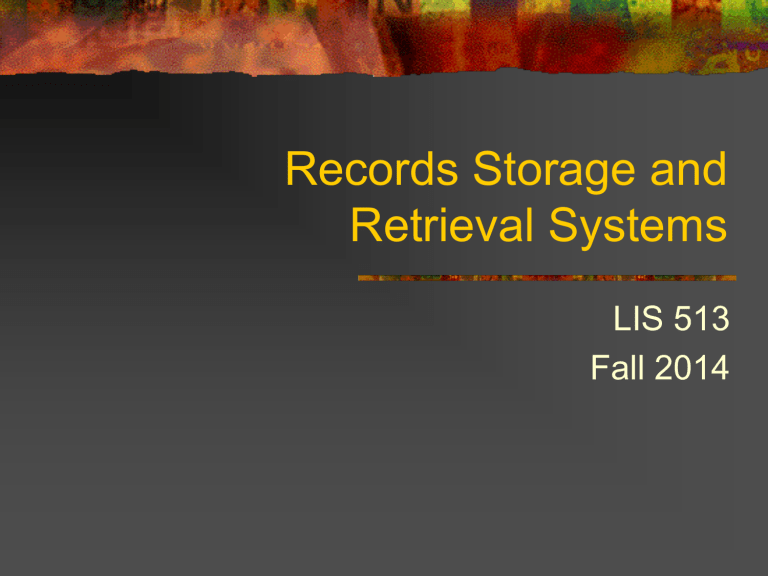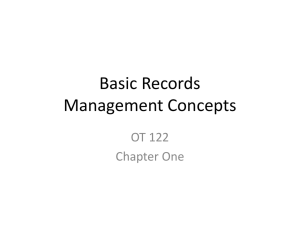102 B 2014 SLIDES

Records Storage and
Retrieval Systems
LIS 513
Fall 2014
Criteria for Selecting Records
Storage and Retrieval Systems
The format of the record
The use of the stored records
Frequency of use
Personnel who use the records
Space requirements or limitations
Protection and security
Length of retention period
Criteria for Selecting Records
Storage and Retrieval Systems
The Format of the Record
What is the format now?
What will the format be in the future?
Criteria for Selecting Records
Storage and Retrieval Systems
The Use of the Stored Record
Used only for reference?
Is there “transaction filing” occurring?
Criteria for Selecting Records
Storage and Retrieval Systems
Frequency of Use
Relates to Productivity and Costs
Has a bearing on personnel, floor space, and maintenance cost for records storage
Expansion of files may hinge on
Reference Ratio
Criteria for Selecting Records
Storage and Retrieval Systems
Personnel Who Use the Records
People who must use the records storage equipment
Filing equipment resources expended depends on who will be using the equipment – high salary vs. lower salary
Criteria for Selecting Records
Storage and Retrieval Systems
Space Requirements or Limitations
How much space is available?
How much will floor space cost?
Two important considerations:
Air space
Aisle space
Criteria for Selecting Records
Storage and Retrieval Systems
Protection and Security
Do records need extra security?
Do you have to limit access?
Are they archival?
Do they need to be protected from extremes of heat and cold?
Are these vital records which REALLY need to be protected from disasters?
Criteria for Selecting Records
Storage and Retrieval Systems
Length of Retention Period
How long do these records need to be held?
If retention period is short, don’t spend a lot on filing equipment!
Storage and Retrieval
Systems
For Active Records
Types of Retrieval Systems
Standard, vertical file-drawer cabinets
High-density file units
Lateral, file-drawer cabinets
Automated or Power
Filing Units
Open-shelf file units
Types of Retrieval Systems
Standard, Vertical File-drawer Cabinets
Most often used for paper-based records
Each drawer holds 2,500 to 3,000 documents
Best for:
Records which are only referenced
Records accessed by only a few people
Types of Retrieval Systems
Standard, Vertical File-drawer Cabinets
DISADVANTAGES:
Amount of floor space required is high.
Only one file worker can access the files in a cabinet at a time
Types of Retrieval Systems
Lateral File-drawer Cabinets
Filing cabinets which open broadside
Designed for quick and easy access to records
ADVANTAGES:
Requires less floor space than vertical filing cabinets
If storing legal records , stores more records per square foot
Types of Retrieval Systems
Open-Shelf File Units
“Bookshelf” cabinets
Provides Easy Access to Records
Best used for high-use records where security is not a concern
Open-Shelf File Units
Advantages
Allows 20-40% faster filing and re-filing
Disadvantages
Individual file folders must be removed from shelves for referencing
Open shelf units require the least floor space of any filing equipment – 50% less than vertical
No security or prevention of unauthorized access
Types of Retrieval Systems
High-density Storage Units
Used for storage of large volumes of highlyactive records
Held on rails – slides from side to side
Similar to open-shelf cabinets but, mobile
High-Density Storage Units
Advantages
Storage of active records/files is much higher per square foot than other filing systems
Disadvantages
Much higher cost compared to other systems
A “permanent” installation with tracks on the floor
Very heavy!!
Types of Retrieval Systems
Automated or Power Filing Units
Also called power systems
Ideal for very large quantities of records which must be retrieved VERY frequently
Often used in centralized operations
Different versions of these systems
Advantages and Disadvantages are the same as highdensity manual systems
File Classification Schemes
Briefly
Numerical
+ Growth is uniform
+ Greater security than alpha system
- Retrieval slower than alpha system
An indirect access system
Alphabetical
+ Retrieval faster than numerical system
A direct access system
- Growth is not uniform
- Less security than numerical system






